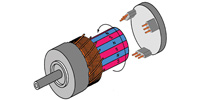
Magnetic Sensing Technology
Applications for integrated magnetic field sensors - where the field-sensitive element resides on the same chip as signal conditioning circuitry - are growing rapidly. The reasons? Integrated sensors are small (which means they can be squeezed into tight spaces) and increasingly affordable since they're subject to the economics of semiconductor manufacturing. At the same time, the cost of the permanent magnets integrated within some magnetic sensors has dropped.
The primary advantage of magnetic sensors is that they do not require physical contact, which helps prevent wear on parts. And, they are largely unaffected by the presence of dirt, dust and even moisture when properly packaged.
One important application for integrated magnetic sensors is in the control of motor drives: A brushless DC motor that uses magnetics to sense the electrical angle of the rotor avoids the eventual wearing away of brush contacts and the maintenance required to replace them: in AC motors they can be used to sense shunt currents for feedback on rotor position and speed.
Position and speed encoder functions like these, both rotational and linear, are also critical for motion control, especially in robotics, where motion has to be smooth and precise in three dimensions, often with compensation for variable loads.
Today, it is the automotive market that is the primary user of affordable, precise and reliable integrated magnetic sensing - in the modern automobile there are as many as 70 magnetic sensors to enhance operation, safety and convenience.
In the passenger compartment magnetic sensors report on whether the doors are closed and seat belts buckled properly. Sensors also automatically guide seats into place, help open windows, turn steering column switches on and off, and track how you turn the steering wheel or press the accelerator.
Under the hood, sensors detect speed and position in the car's engine, transmission and electric motors. Other sensors monitor fluid levels, track body and wheel position, perform a number of safety checks, and sense currents for a variety of electrical feedback and measurement functions.
Learn more about magnetic sensors for sensing position, speed, current, and many other conditions in the Texas Instruments white paper "Achieve greater precision, reliability with integrated magnetic sensing technology".

























